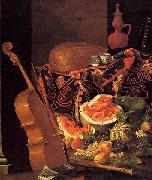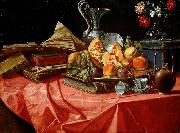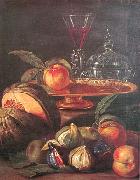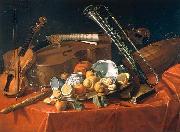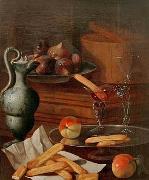Cristoforo Munari Huiler la Reproduction de TableauAll Cristoforo Munari Oil Paintings(July 21, 1667 - June 3, 1720) was an Italian painter of the late-Baroque specializing in still life paintings. He was also known as Cristofano Monari. His initial training was in Reggio Emilia, his birthplace, and he came under the patronage of Rinaldo d'Este, Duke of Modena. In 1703-1706, he lived in Rome, then moved to Florence, where for about a decade he was attached to the court of the Medici. His still life paintings recall those of Evaristo Baschenis; however, the added disarray of porcelain, glass, and foodstuffs, suggest the hangover from the jovial surfeit of the Medici court. He painted also panoplies and war trophies. In 1715 he moved to Pisa where he worked almost exclusively in art restoration; he died in 1720. An exhibition of his paintings took place in 1998 in Reggio Emilia, where it attracted wide attention and was a national success. |
|||

|
|||
|
|
|||
|
||||||||||||
| Cristoforo Munari (July 21, 1667 - June 3, 1720) was an Italian painter of the late-Baroque specializing in still life paintings. He was also known as Cristofano Monari. His initial training was in Reggio Emilia, his birthplace, and he came under the patronage of Rinaldo d'Este, Duke of Modena. In 1703-1706, he lived in Rome, then moved to Florence, where for about a decade he was attached to the court of the Medici. His still life paintings recall those of Evaristo Baschenis; however, the added disarray of porcelain, glass, and foodstuffs, suggest the hangover from the jovial surfeit of the Medici court. He painted also panoplies and war trophies. In 1715 he moved to Pisa where he worked almost exclusively in art restoration; he died in 1720. An exhibition of his paintings took place in 1998 in Reggio Emilia, where it attracted wide attention and was a national success. |
||||||||||||
|
|
||||||||||||
| ID de tableau:: 74873 Still-Life with Musical Instruments and Fruit Still-Life with Musical Instruments and Fruit 17th/18th century Oil on canvas cjr 17th/18th century Oil on canvas cjr |
||||||||||||
|
|
||||||||||||
| ID de tableau:: 75844 vasetto di fiori e teiera su tavolo coperto da tovaglia rossa vasetto di fiori e teiera su tavolo coperto da tovaglia rossa Oil on canvas Dimensions 88.0x115.0 cm cyf Oil on canvas Dimensions 88.0x115.0 cm cyf |
||||||||||||
|
|
||||||||||||
| ID de tableau:: 75848 Vases Glass and Fruit Vases Glass and Fruit Date 1706 - 1713 Medium Oil on canvas cyf Date 1706 - 1713 Medium Oil on canvas cyf |
||||||||||||
|
|
||||||||||||
| ID de tableau:: 75879 Stilleben mit Musikinstrumenten und Fruchten Stilleben mit Musikinstrumenten und Fruchten Date c. 1706-03 Medium Oil on canvas cyf Date c. 1706-03 Medium Oil on canvas cyf |
||||||||||||
|
|
||||||||||||
| ID de tableau:: 75913 Glaser und Loffelbiskuits Glaser und Loffelbiskuits Date c. 1714 Medium Oil on canvas Dimensions 70,5 x 58,5 cm cyf Date c. 1714 Medium Oil on canvas Dimensions 70,5 x 58,5 cm cyf |
||||||||||||
|
|
||||||||||||
| Artiste précédent Artiste prochain | ||||||||||||
|
|
||||||||||||
|
Cristoforo Munari (July 21, 1667 - June 3, 1720) was an Italian painter of the late-Baroque specializing in still life paintings. He was also known as Cristofano Monari. His initial training was in Reggio Emilia, his birthplace, and he came under the patronage of Rinaldo d'Este, Duke of Modena. In 1703-1706, he lived in Rome, then moved to Florence, where for about a decade he was attached to the court of the Medici. His still life paintings recall those of Evaristo Baschenis; however, the added disarray of porcelain, glass, and foodstuffs, suggest the hangover from the jovial surfeit of the Medici court. He painted also panoplies and war trophies. In 1715 he moved to Pisa where he worked almost exclusively in art restoration; he died in 1720. An exhibition of his paintings took place in 1998 in Reggio Emilia, where it attracted wide attention and was a national success. |
||||||||||||
|
|
||||||||||||
|
CONTACTER DES Etats-Unis |





